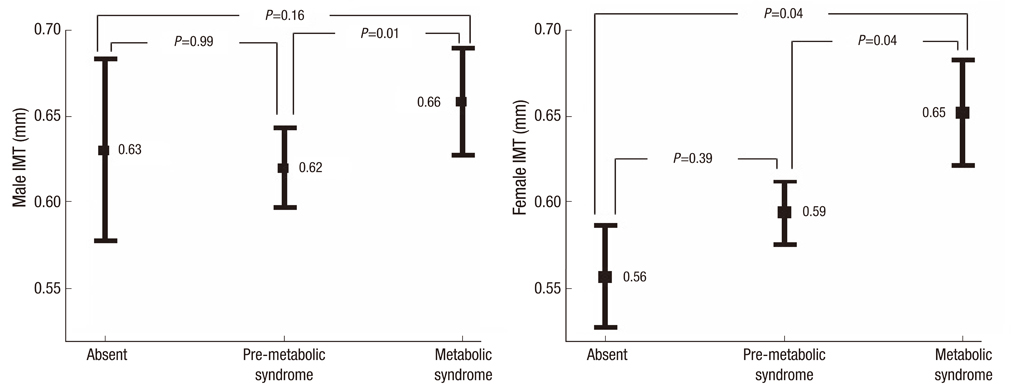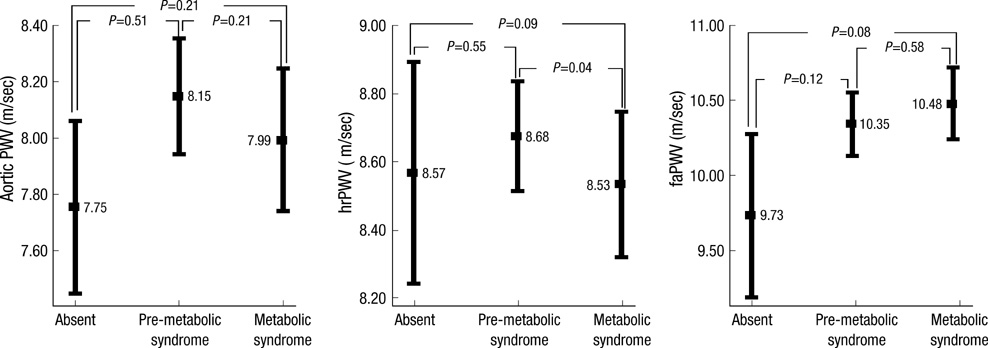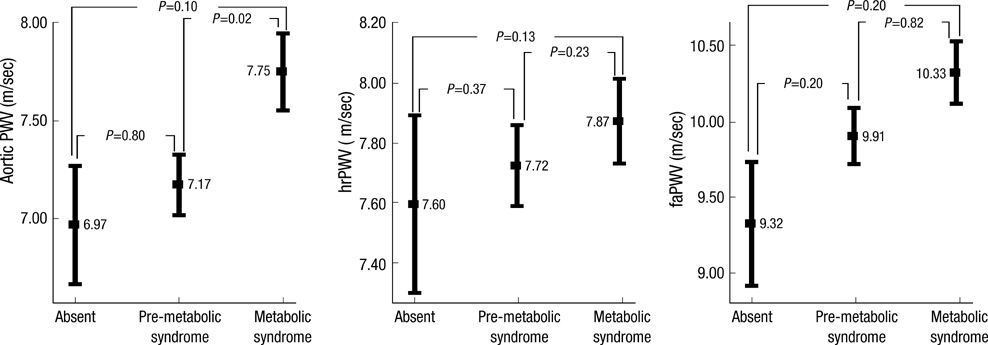J Korean Med Sci.
2010 Jul;25(7):1045-1052. 10.3346/jkms.2010.25.7.1045.
Cardiovascular Parameters Correlated with Metabolic Syndrome in a Rural Community Cohort of Korea: The ARIRANG Study
- Affiliations
-
- 1Division of Cardiology, Pusan National University Hospital, Busan, Korea.
- 2Division of Cardiology, Wonju College of Medicine, Yonsei University, Wonju, Korea. kimjy@yonsei.ac.kr
- 3Department of Preventive Medicine, Institute of Genomic Cohort, Wonju College of Medicine, Yonsei University, Wonju, Korea.
- KMID: 1792955
- DOI: http://doi.org/10.3346/jkms.2010.25.7.1045
Abstract
- Although metabolic syndrome (MetS) is associated with increased cardiovascular mortality and the development of atherosclerosis, consensus is still lacking on the status of cardiovascular function and geometry in MetS patients. We investigated the relation between MetS and left ventricle (LV) geometry and function, carotid intima-media thickness (IMT) and arterial stiffness in a community-based cohort of 702 adult subjects. Subjects were categorized into three groups according to the number of MetS components present, as defined by the Adult Treatment Panel III guidelines: 1) Absent (0 criteria), 2) Pre-MetS (1-2 criteria) or 3) MetS (> or =3 criteria). In female subjects, LV mass, LV mass/height(2.7), deceleration time, and aortic pulse wave velocity increased, and E/A ration decreased in a stepwise manner across the three groups. These changes were not observed in male subjects. The mean carotid IMT was higher in the MetS group than in the other two groups. The degree of MetS clustering is found to be strongly correlated with geometric eccentricity of LV hypertrophy, diastolic dysfunction and arterial changes irrespective of age and blood pressure status, particularly in females. Waist circumference is found to have the most powerful effect on cardiovascular parameters.
MeSH Terms
-
Adult
Aged
Cardiovascular Diseases/etiology/*physiopathology
Cardiovascular System/pathology/*physiopathology
Carotid Arteries/anatomy & histology/physiology
*Cohort Studies
Female
Heart Ventricles/anatomy & histology
Humans
Korea
Male
Metabolic Syndrome X/complications/*physiopathology
Middle Aged
*Rural Population
Ventricular Function, Left/physiology
Figure
Reference
-
1. National Cholesterol Education Program (NCEP) Expert Panel on Detection, Evaluation, and Treatment of High Blood Cholesterol in Adults (Adult Treatment Panel III). Third Report of the National Cholesterol Education Program (NCEP) Expert Panel on Detection, Evaluation, and Treatment of High Blood Cholesterol in Adults (Adult Treatment Panel III) final report. Circulation. 2002. 106:3143–3421.2. Park JS, Park HD, Yun JW, Jung CH, Lee WY, Kim SW. Prevalence of the metabolic syndrome as defined by NCEP-ATPIII among the urban Korean population. Korean J Med. 2002. 63:290–298.3. Ford ES, Giles WH, Dietz WH. Prevalence of the metabolic syndrome among US adults: findings from the third National Health and Nutrition Examination Survey. JAMA. 2002. 287:356–359.
Article4. Alberti KG, Zimmet P, Shaw J. The metabolic syndrome--a new worldwide definition. Lancet. 2005. 366:1059–1062.
Article5. Lakka HM, Laaksonen DE, Lakka TA, Niskanen LK, Kumpusalo E, Tuomilehto J, Salonen JT. The metabolic syndrome and total and cardiovascular disease mortality in middle-aged men. JAMA. 2002. 288:2709–2716.
Article6. Ninomiya JK, L'Italien G, Criqui MH, Whyte JL, Gamst A, Chen RS. Association of the metabolic syndrome with history of myocardial infarction and stroke in the Third National Health and Nutrition Examination Survey. Circulation. 2004. 109:42–46.
Article7. de Simone G, Olsen MH, Wachtell K, Hille DA, Dahlof B, Ibsen H, Kjeldsen SE, Lyle PA, Devereux RB. Clusters of metabolic risk factors predict cardiovascular events in hypertension with target-organ damage: the LIFE study. J Hum Hypertens. 2007. 21:625–632.
Article8. Schiller NB, Shah PM, Crawford M, DeMaria A, Devereux R, Feigenbaum H, Gutgesell H, Reichek N, Sahn D, Schnittger I, Silverman NH, Tajik AJ. Recommendations for quantitation of the left ventricle by two-dimensional echocardiography. American Society of Echocardiography Committee on Standards, Subcommittee on Quantitation of Two-Dimensional Echocardiograms. J Am Soc Echocardiogr. 1989. 2:358–367.9. Devereux RB, Alonso DR, Lutas EM, Gottlieb GJ, Campo E, Sachs I, Reichek N. Echocardiographic assessment of left ventricular hypertrophy: comparison to necropsy findings. Am J Cardiol. 1986. 57:450–458.
Article10. de Simone G, Daniels SR, Devereux RB, Meyer RA, Roman MJ, de Divitiis O, Alderman MH. Left ventricular mass and body size in normotensive children and adults: assessment of allometric relations and impact of overweight. J Am Coll Cardiol. 1992. 20:1251–1260.
Article11. Sahn DJ, DeMaria A, Kisslo J, Weyman A. Recommendations regarding quantitation in M-mode echocardiography: results of a survey of echocardiographic measurements. Circulation. 1978. 58:1072–1083.
Article12. Lang RM, Bierig M, Devereux RB, Flachskampf FA, Foster E, Pellikka PA, Picard MH, Roman MJ, Seward J, Shanewise JS, Solomon SD, Spencer KT, Sutton MS, Stewart WJ. Recommendations for chamber quantification: a report from the American Society of Echocardiography's Guidelines and Standards Committee and the Chamber Quantification Writing Group, developed in conjunction with the European Association of Echocardiography, a branch of the European Society of Cardiology. J Am Soc Echocardiogr. 2005. 18:1440–1463.
Article13. Quinones MA, Otto CM, Stoddard M, Waggoner A, Zoghbi WA. Recommendations for quantification of Doppler echocardiography: a report from the Doppler Quantification Task Force of the Nomenclature and Standards Committee of the American Society of Echocardiography. J Am Soc Echocardiogr. 2002. 15:167–184.14. Dumesnil JG, Paulin C, Pibarot P, Coulombe D, Arsenault M. Mitral annulus velocities by Doppler tissue imaging: practical implications with regard to preload alterations, sample position, and normal values. J Am Soc Echocardiogr. 2002. 15:1226–1231.
Article15. Sohn DW, Chai IH, Lee DJ, Kim HC, Kim HS, Oh BH, Lee MM, Park YB, Choi YS, Seo JD, Lee YW. Assessment of mitral annulus velocity by Doppler tissue imaging in the evaluation of left ventricular diastolic function. J Am Coll Cardiol. 1997. 30:474–480.
Article16. O'Leary DH, Polak JF, Kronmal RA, Manolio TA, Burke GL, Wolfson SK Jr. Cardiovascular Health Study Collaborative Research Group. Carotid-artery intima and media thickness as a risk factor for myocardial infarction and stroke in older adults. N Engl J Med. 1999. 340:14–22.17. Chinali M, de Simone G, Roman MJ, Best LG, Lee ET, Russell M, Howard BV, Devereux RB. Cardiac markers of pre-clinical disease in adolescents with the metabolic syndrome: the strong heart study. J Am Coll Cardiol. 2008. 52:932–938.18. Grandi AM, Maresca AM, Giudici E, Laurita E, Marchesi C, Solbiati F, Nicolini E, Guasti L, Venco A. Metabolic syndrome and morphofunctional characteristics of the left ventricle in clinically hypertensive nondiabetic subjects. Am J Hypertens. 2006. 19:199–205.
Article19. Mule G, Nardi E, Cottone S, Cusimano P, Volpe V, Piazza G, Mongiovi R, Mezzatesta G, Andronico G, Cerasola G. Influence of metabolic syndrome on hypertension-related target organ damage. J Intern Med. 2005. 257:503–513.
Article20. Sundstrom J, Arnlov J, Stolare K, Lind L. Blood pressure-independent relations of left ventricular geometry to the metabolic syndrome and insulin resistance: a population-based study. Heart. 2008. 94:874–878.
Article21. Schillaci G, Pirro M, Pucci G, Mannarino MR, Gemelli F, Siepi D, Vaudo G, Mannarino E. Different impact of the metabolic syndrome on left ventricular structure and function in hypertensive men and women. Hypertension. 2006. 47:881–886.
Article22. Golden SH, Folsom AR, Coresh J, Sharrett AR, Szklo M, Brancati F. Risk factor groupings related to insulin resistance and their synergistic effects on subclinical atherosclerosis: the atherosclerosis risk in communities study. Diabetes. 2002. 51:3069–3076.
Article23. Scuteri A, Najjar SS, Muller DC, Andres R, Hougaku H, Metter EJ, Lakatta EG. Metabolic syndrome amplifies the age-associated increases in vascular thickness and stiffness. J Am Coll Cardiol. 2004. 43:1388–1395.
Article24. Schillaci G, Pirro M, Vaudo G, Mannarino MR, Savarese G, Pucci G, Franklin SS, Mannarino E. Metabolic syndrome is associated with aortic stiffness in untreated essential hypertension. Hypertension. 2005. 45:1078–1082.
Article25. Ferreira I, Henry RM, Twisk JW, van Mechelen W, Kemper HC, Stehouwer CD. The metabolic syndrome, cardiopulmonary fitness, and subcutaneous trunk fat as independent determinants of arterial stiffness: the Amsterdam Growth and Health Longitudinal Study. Arch Intern Med. 2005. 165:875–882.26. Ferreira I, Boreham CA, Twisk JW, Gallagher AM, Young IS, Murray LJ, Stehouwer CD. Clustering of metabolic syndrome risk factors and arterial stiffness in young adults: the Northern Ireland Young Hearts Project. J Hypertens. 2007. 25:1009–1020.
Article
- Full Text Links
- Actions
-
Cited
- CITED
-
- Close
- Share
- Similar articles
-
- The Relationship between Heart Rate Variability and Metabolic Syndrome at a Rural Area
- The hs-CRP Levels and the Metabolic Syndrome according to Glucose Intolerance in Inhabitants of Rural Communities
- The Prevalence and the Related Factors of Metabolic Syndrome in Urban and Rural Community
- The Association between hs-CRP Concentration of Blood and Metabolic Syndrome in the Residents of a Rural Community
- Assessment of Metabolic Syndrome Risk Based on Body Size Phenotype in Korean Adults: Analysis of Community-based Cohort Data




